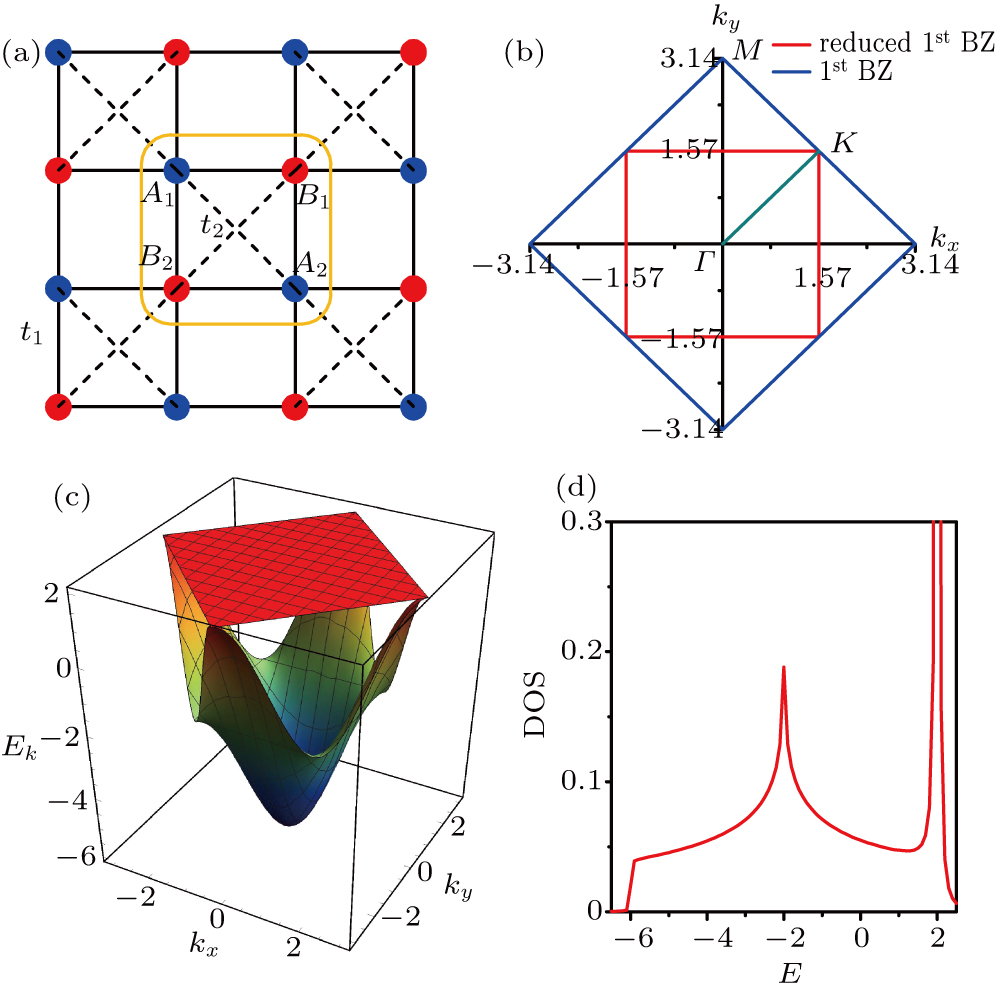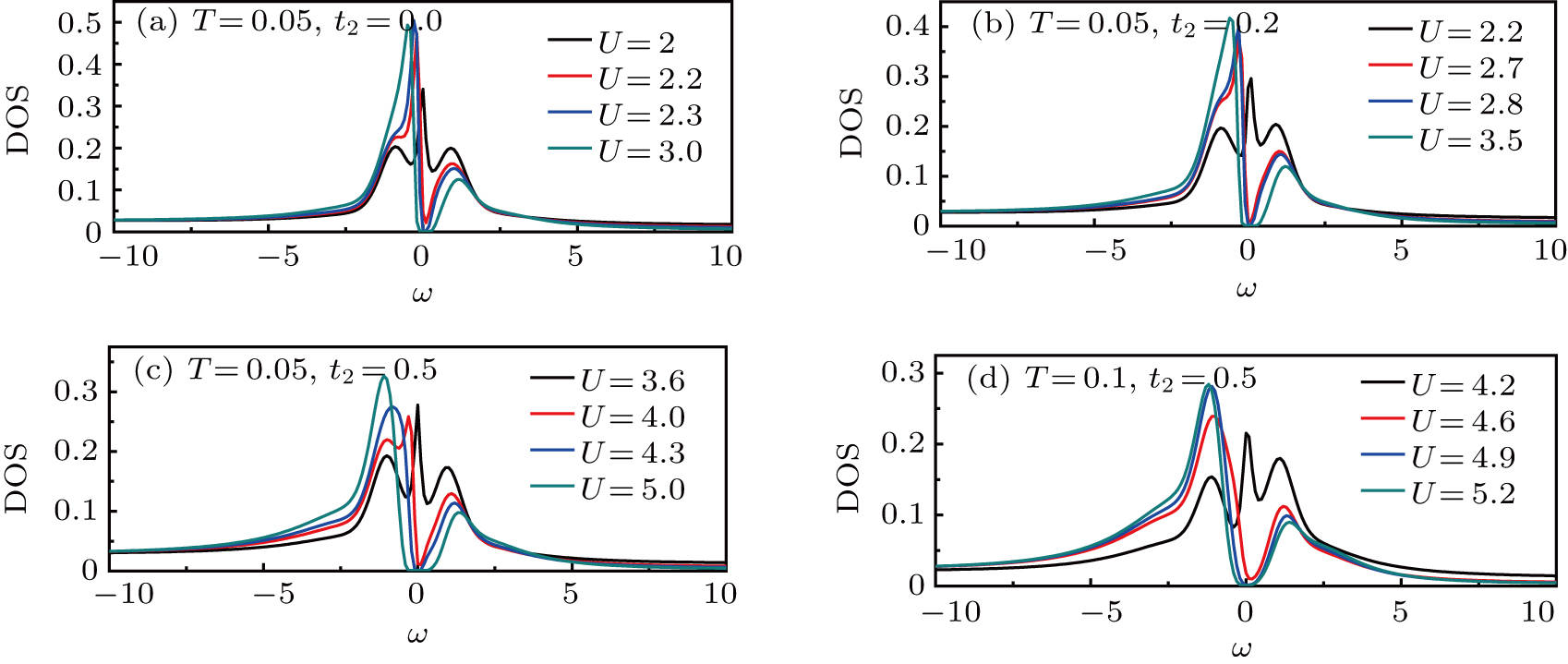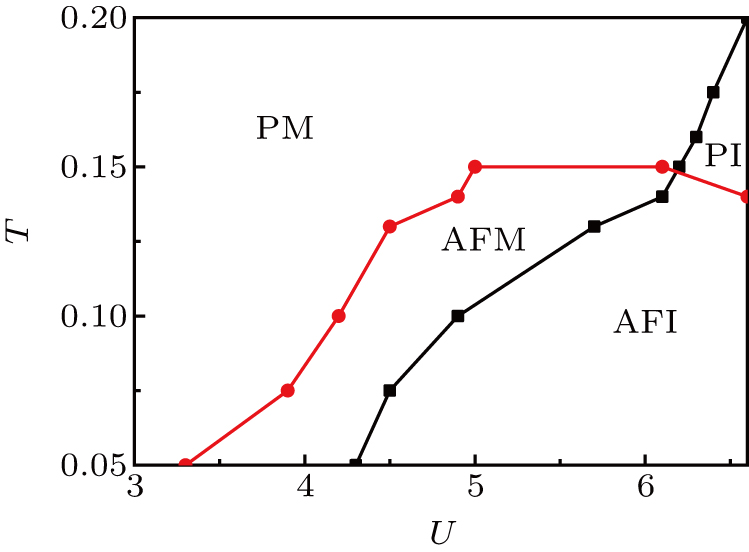† Corresponding author. E-mail:
We study magnetic and Mott transitions of the Hubbard model on the geometrically frustrated anisotropic checkerboard lattice at half filling using cellular dynamical mean-field theory. Phase diagrams over a wide area of the parameter space are obtained by varying the interparticle interaction strength, geometric frustration strength, and temperature. Our results show that frustration and thermal fluctuations play a competing role against the interactions and in general favor a metallic phase without antiferromagnetic order. Due to their interplay, the system exhibits competition between antiferromagnetic insulator, antiferromagnetic metal, paramagnetic insulator, and paramagnetic metal phases in the intermediate-interaction regime. In the strong-interaction limit, which reduces to the Heisenberg model, our result is consistent with previous studies.
Geometrical frustration in the strongly correlated systems has attracted considerable attention recently and was widely studied.[1–9] Strong interparticle interactions are known to play a key role in many interesting phenomena in condensed matter physics, including Mott transition and high-temperature superconductivity,[10–12] but it still remains a challenge to fully understand them due to the break down of perturbative approaches. Geometric frustration, on the other hand, describes a phenomenon where, due to geometry, global minimization of inter-particle interaction energies cannot be trivially achieved, resulting in various non-trivial ground state configurations, such as quantum spin liquid, spin ice, and spin glass.[13–15] Antiferromagnetically interacting spins arranged with certain geometries, e.g., on a triangular lattice, are a typical type of systems that host geometric frustration. Geometric frustration also plays an important role in interacting electronic systems, especially in half-filled Hubbard models on geometrically frustrated lattices, whose strongly-interacting limit reduces to spin models. It is intriguing to investigate the competition between interaction and geometrical frustration in such systems, which exhibit fascinating interplay between magnetic transitions and metal–insulator transitions, leading to novel phases and rich phase diagrams.
For antiferromagnetically interacting spins, the simplest two-dimensional (2D) geometry that leads to geometric frustration is a triangle, which can be extended to a triangular lattice or a kagome lattice. In three-dimension (3D), the simplest example is a tetrahedron, whose 3D extension describes magnetic properties of some transition-metal oxides, such as LiV2O4 and Tl2Ru2O7.[5–7] Similarly, one can construct a 2D lattice with a layer of vertex-sharing tetrahedra. It is topologically equivalent to a 2D square lattice with selected diagonal links, as shown in Fig. 


We consider the standard Hubbard model on the anisotropic checkerboard lattice at half filling. Its Hamiltonian can be written as
 |





To start with, we first look at the non-interacting (U = 0) band structure, which is readily obtained by diagonalizing the kinetic-energy terms (the first two terms on the right hand side of Eq. (
 |



Our analysis of the interplay between geometrical frustration and electron–electron interaction in the half-filled checkerboard lattice is bases on the cellular dynamical mean-field theory (CDMFT)[33–35] calculation combined with continuous time quantum Monte Carlo method (CTQMC),[36,37] which has been widely applied to strongly correlated geometrically frustrated systems. The main idea of CDMFT is to map a system on a lattice to an impurity model by considering a cluster embedded in a self-consistent effective Weiss field. This impurity model is then solved using CTQMC, which updates the effective Weiss field and completes one self-consistent loop. Using this CDMFT approach, we calculate the single-particle Greenʼs function at imaginary frequencies, which is then analytically continued to real frequencies via the maximum entropy method.[38] With the single-particle Greenʼs function, one can further calculate physical quantities like DOS, magnetization, and spectral functions.
In our calculation, we choose four sites marked by a yellow circle as one cluster as shown in Fig. 
We focus on two important aspects of phase transitions in this system, metal–insulator transitions and magnetic transitions. The former is identified by looking at the DOS, where an energy gap at the chemical potential indicates an insulating phase, and vice versa. The latter is determined through the corresponding magnetic order parameter.
For fixed frustration strength t2, the system goes through the typical Mott transition to a insulating phase when the interaction strength U is increased. This can be seen from Fig.
For example, Figure 







To gain a finer view of the Mott transition, it is instructive to look at the double occupancy (Docc) defined as 

In addition, we further calculate the distribution of the spectral weight at the chemical potential with different interaction strength. It is a good characterization of interaction effects and can be directly accessed via angle resolved photoemission spectroscopy (ARPES) experiments. The result with T=0.05, 

For magnetic transition, we focus on the antiferromagnetic order and define the order parameter as 



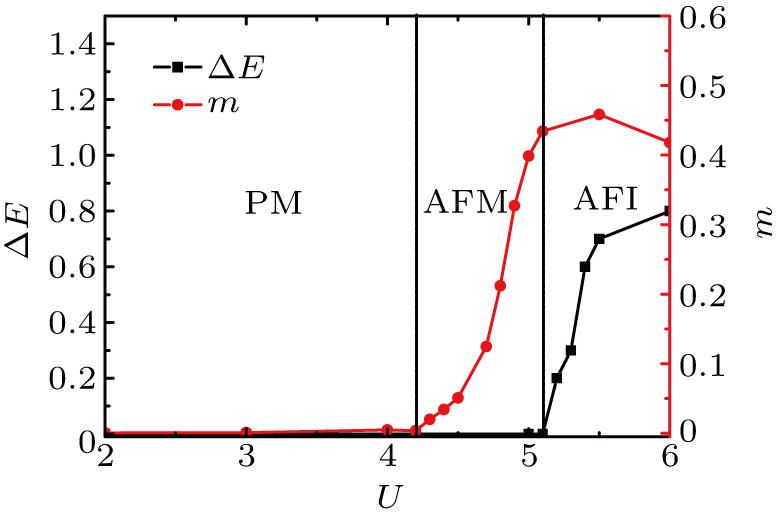 | Fig. 6. Antiferromagnetic order parameter m and single-particle energy-gap 

|
With the information of the energy gap, one can further see that the development of a nonzero energy gap and a nonzero antiferromagnetic order do not occur simultaneously when T=0.05, 



Based on the above analysis of Mott transitions and magnetic transitions, we are ready to present phase diagrams which cover a wide area of the parameter space.
We first look at the result near zero temperature. Because zero temperature is not accessible through CTQMC, we approach the zero-temperature case by calculating at low temperatures, and a low-temperature (T=0.05) phase diagram in the t2–U plane is shown in Fig. 

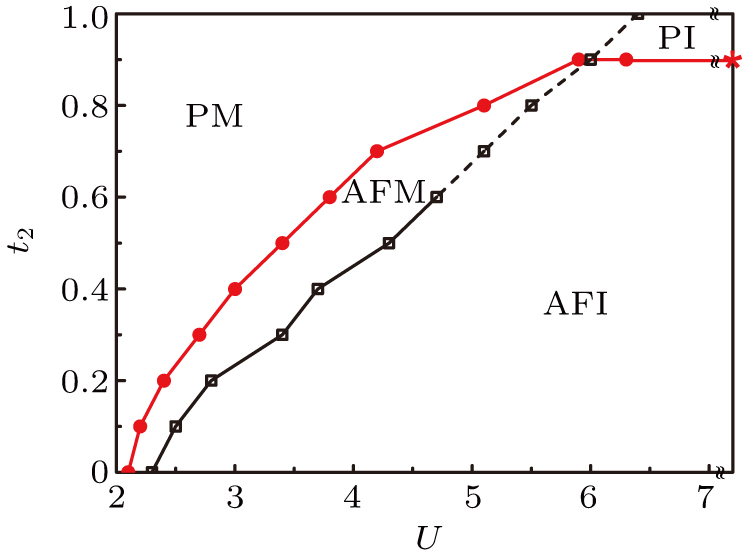 | Fig. 7. Phase diagram in the t2–U space with T=0.05. The red line is the phase boundary between the paramagnetic phase and the antiferromagnetic phase. The black line indicates the Mott transition (dashed line for first-order transitions and solid line for continuous ones). These two kinds of transitions divide the phase diagram to regions corresponding to paramagnetic metal (PM), antiferromagnetic metal (AFM), antiferromagnetic insulator (AFI), and paramagnetic insulator (PI) phases. The red star marks the critical point of the magnetic transition of the Heisenberg limit (
|
We also investigated the effect of thermal fluctuations by presenting a phase diagram on the T–U plane at a fixed frustration strength 
To summarize, we have studied Mott transitions and antiferromagnetic transitions on a half-filled anisotropic checkerboard lattice by means of the cellular dynamical mean field theory combined with the continuous-time quantum Monte Carlo method. We benchmark our calculation by looking at the critical frustration strength in the large-U limit, which can be effectively described by an antiferromagnetic Heisenberg model, and our result is consistent with previous studies. The interplay between frustrations (t2) (or anisotropy with the isotropic case being most frustrated), interparticle interactions (U), and thermal fluctuations (T) are investigated by varying the corresponding parameters. Through numerical simulations in a wide area of the parameter space, we extract phase diagrams of the system in the t2–U and T–U spaces. At fixed temperature and frustration strength, the interaction drives a Mott transition. When the interaction is sufficiently strong, the lattice sites are nearly singly occupied, and the system is in the insulating phase. This transition is accompanied by a magnetic transition, which tends to produce antiferromagnetic order when the interaction is strong. Thermal fluctuations and frustrations, on the other hand, play a competing role and favor metallic phases, and the magnetic order can be completely suppressed when t2 and T exceed certain values. Besides, they further complicate the phase diagram by opening a narrow window for an antiferromagnetic metal phase. We hope that our study can provide useful information for future research on strongly-interacting systems on checkerboard lattices and related materials.
| [1] | |
| [2] | |
| [3] | |
| [4] | |
| [5] | |
| [6] | |
| [7] | |
| [8] | |
| [9] | |
| [10] | |
| [11] | |
| [12] | |
| [13] | |
| [14] | |
| [15] | |
| [16] | |
| [17] | |
| [18] | |
| [19] | |
| [20] | |
| [21] | |
| [22] | |
| [23] | |
| [24] | |
| [25] | |
| [26] | |
| [27] | |
| [28] | |
| [29] | |
| [30] | |
| [31] | |
| [32] | |
| [33] | |
| [34] | |
| [35] | |
| [36] | |
| [37] | |
| [38] | |
| [39] | |
| [40] | |
| [41] |


